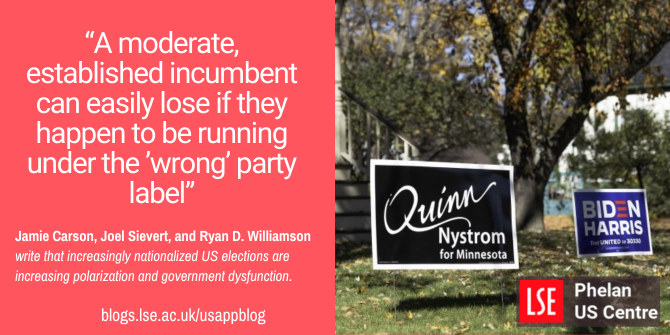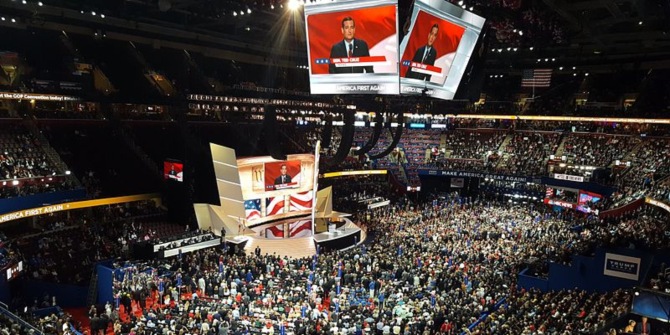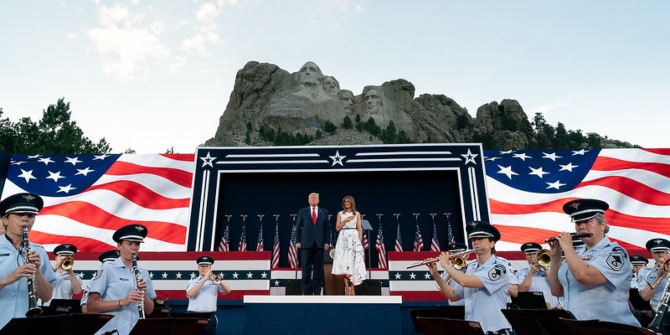

 For much of the 20th century Congressional candidates’ qualities were one of the most important factors in voters’ decisions about who they sent to Congress. In a new book, Jamie Carson, Joel Sievert, and Ryan D. Williamson track the nationalization of US elections in recent decades. They write that the correlation between presidential and congressional election results has become especially strong in recent decades. This trend has led to a declining electoral advantage for incumbents, and increased polarization and dysfunction in Congress as it has become easier for political amateurs to successfully run for office.
For much of the 20th century Congressional candidates’ qualities were one of the most important factors in voters’ decisions about who they sent to Congress. In a new book, Jamie Carson, Joel Sievert, and Ryan D. Williamson track the nationalization of US elections in recent decades. They write that the correlation between presidential and congressional election results has become especially strong in recent decades. This trend has led to a declining electoral advantage for incumbents, and increased polarization and dysfunction in Congress as it has become easier for political amateurs to successfully run for office.
In the United States, politics has become increasingly nationalized in recent years as voter decision-making is now driven by partisan or national political forces rather than the attributes of individual candidates. Indeed, voters now seem more concerned with which of the two national parties will be in power across all levels of government and less concerned with which candidate is best equipped to represent them individually, locally, or even collectively.
Our new book, Nationalized Politics: Evaluating Electoral Politics Across Time, chronicles the waxing and waning of nationalization of US elections between 1840 and 2020. We use this historical variation to examine the relationship between nationalization and other important features of congressional elections such as competition, polarization, and the incumbency advantage. In doing so, we uncover some new insights about the current state of elections and what that might mean for future cycles.
Nationalization isn’t new to American politics, but this type of nationalization is
Elections during the nineteenth century were largely nationalized because of the electoral system in place—namely that of the party strip ballot that was widely used. When voters went to the polls, they chose either the Democratic or Republican ballot, leading them to vote a straight party ticket by default. Voting was also done in the open. Without the privacy of the secret ballot, voters were subject to pressure from party bosses and their henchmen to vote for the “correct” slate of candidates. Thus, it was incredibly difficult to stray from the party slate of candidates during this era, which resulted in more nationalized elections until the adoption of the Australian or secret ballot in the late nineteenth century.
In the modern era, voters can freely choose among both parties’ candidates via the office bloc ballot commonly used by the states. Participants are also no longer subjected to the same pressures as before given that their ballots are now cast in secret. However, the national rhetoric surrounding campaigns tends to focus on national issues reflecting the candidates at the top of the ticket (e.g., the president). This effect has been magnified in recent elections even before presidents started more regularly playing the role of “nationalizer in chief.”

“Quinn Nystrom for Minnesota, Tina Smith” (CC BY 2.0) by Lorie Shaull
As Figure 1 shows, the correlation between presidential and congressional elections has become especially strong in recent decades. Each dot represents the Democratic presidential candidate’s vote share relative to the Democratic House candidate’s vote share in each election cycle. The clustering of dots around the diagonal represents more uniform voting behavior typically associated with increased nationalization.
Figure 1 – Correlation between Democratic presidential and Congressional vote share

This shows how similar elections in the mid-1800s are to elections in the 21st century, and how different elections from both time periods are to elections in the mid-1900s. Therefore, despite the wholesale changes to the voting experience implemented during the early twentieth century, voting has reverted to the high levels of nationalization seen during the 1800s. This leads candidates to focus less on local issues and more on topics that are largely relevant on the national stage.
What does this mean for elections?
Much like during the era of the party ballot, today’s highly nationalized elections mean that the electoral fate of the presidential candidate and candidates in down-ballot races are inextricably linked. For example, during the 2016 and 2020 election, only one state saw a senator from one party and a presidential candidate from the other party win statewide (e.g., Maine in 2020). In every other state, if the Republican presidential candidate prevailed, so did the Republican senatorial candidate. And if the Democratic presidential candidate won, so too did the Democratic senatorial candidate.
When voters are casting ballots based on which party they want to see in power, it has drastic consequences for other aspects of elections. For example, a member of Congress in decades past may have been able to cultivate a personal reputation independent of their party’s brand to maintain good standing among his or her constituency and win in a district that leans in the opposite partisan direction. However, an incumbent’s ability to do this has substantially diminished as party increasingly trumps individual characteristics. Therefore, increasing nationalization can decrease the incumbency advantage to the point that incumbents now only receive a one or two percentage point boost when running for reelection.
As the experience and characteristics of individual candidates decrease in importance in the minds of voters, it becomes far easier for political amateurs to successfully run for office. Since amateurs are generally more ideologically extreme than those who have previously served in some sort of elected position (e.g., a city council or the state legislature), an increasing percentage of amateurs serving in Congress leads to more polarizing behavior. This is exactly what has been happening in recent years as fewer moderates are running and winning compared to decades past, which, in turn, leads to more ideologically extreme candidates winning by default. In short, nationalization opens the door for more extreme candidates to run and makes it easier for them to win as well.
Both changes have implications for our understanding of competition and polarization in Congress. Previously, we may have viewed a more moderate, established incumbent as a near-certain winner in an election against an inexperienced ideologue. Additionally, amateur candidates with little in the way of campaign funds and knowledge of local issues and priorities could have easily been written off in years past. However, neither of these things are true today. A moderate, established incumbent can easily lose if they happen to be running under the “wrong” party label at the time; and, conversely, an inexperienced ideologue without ties to the community can propel themselves to victory simply by identifying with the “right” party.
That is not to say that individual characteristics do not matter at all. Increased nationalization does mean, though, that individual characteristics are unlikely to matter enough to flip enough votes to change the outcome of any given race.
What does this mean for the future?
Our work demonstrates a strong linkage between nationalization and polarization. The most recent example of this comes as the House of Representatives is struggling to pass a budget for the upcoming fiscal year and took weeks to elect a new Speaker following Kevin McCarthy’s removal from power. If US politics does not move away from highly nationalized rhetoric, the current levels of dysfunction and polarization are only going to get worse in the future.
Many of the reforms that were adopted in the early twentieth century played a crucial role in reducing nationalization at the time as well as the greater levels of polarized politics that accompanied it. However, we may need to think creatively about other options to reduce the nationalized rhetoric that is affecting our political system today. Since nationalization is now being driven by individual preferences and not electoral institutions, reforms that worked previously may not produce the desired outcome of their advocates if they do not somehow change the incentive structure for voters as well.
- This article is based on the new book, Nationalized Politics: Evaluating Electoral Politics Across Time.
- Please read our comments policy before commenting.
- Note: This article gives the views of the author, and not the position of USAPP – American Politics and Policy, nor the London School of Economics.
- Shortened URL for this post: https://bit.ly/3udff0j






